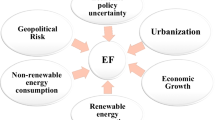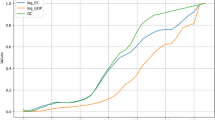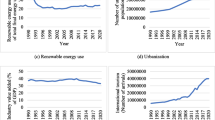Abstract
This study conducts a comprehensive analysis of CO2 emissions trends from 1990 to 2020 across critical sectors including agriculture, buildings, electricity, industry, oil and gas, and waste. Leveraging a robust dataset of 35,000 observations, we explore emission patterns and their impact on climate change mitigation efforts. Employing advanced time series models—such as the Drift Method, Holt Linear Method, Damped Trend Method, and ARIMA—we forecast emissions and evaluate these models using RMSE, MAE, and MAPE to gauge their predictive accuracy. This research aims to assess the feasibility for various countries to meet the Paris Agreement’s goal of limiting global warming to 1.5 \(^\circ \)C, aligned with the IPCC AR6 report’s benchmarks for emissions peaking by 2025 and a 43% reduction by 2030. Our analysis reveals critical insights into emission trajectories, underscoring the urgency and practicality of achieving global climate objectives. The findings serve as a crucial guide for policymakers in crafting informed, sustainable development strategies.
Access this chapter
Tax calculation will be finalised at checkout
Purchases are for personal use only
Similar content being viewed by others
References
The climate action tracker. https://climateactiontracker.org/. Accessed 15 Feb 2024
Climate change 2023 - synthesis report summary for policymakers. https://www.ipcc.ch/report/ar6/syr/downloads/report/IPCC_AR6_SYR_SPM.pdf. Accessed 15 Feb 2024
Net zero by 2050 - a roadmap for the global energy sector. https://www.iea.org/reports/net-zero-by-2050. Accessed 15 Feb 2024
The sustainable development goals report 2022. https://unstats.un.org/sdgs/report/2022/. Accessed 15 Feb 2024
Transforming our world: The 2030 agenda for sustainable development. https://sustainabledevelopment.un.org/content/documents/21252030%20Agenda%20for%20Sustainable%20Development%20web.pdf. Accessed 15 Feb 2024
Bodansky, D.: The Paris climate change agreement: a new hope? Am. J. Int. Law 110(2), 288–319 (2016)
Dodson, J., Dérer, P., Cafaro, P., Götmark, F.: Population growth, family planning and the Paris agreement: an assessment of the nationally determined contributions (NDCS). Int. Environ. Agreements Polit. Law Econ. 22(3), 561–576 (2022)
Kanavos, A., Kounelis, F., Iliadis, L., Makris, C.: Deep learning models for forecasting aviation demand time series. Neural Comput. Appl. 33(23), 16329–16343 (2021)
Kanavos, A., Trigka, M., Dritsas, E., Vonitsanos, G., Mylonas, P.: A regularization-based big data framework for winter precipitation forecasting on streaming data. Electronics 10(16), 1872 (2021)
Karamitsos, I., Papadaki, M., Al-Hussaeni, K., Kanavos, A.: Transforming airport security: enhancing efficiency through blockchain smart contracts. Electronics 12(21), 4492 (2023)
Kumari, S., Singh, S.K.: Machine learning-based time series models for effective CO2 emission prediction in India. Environ. Sci. Pollut. Res. 30(55), 116601–116616 (2023)
Kunda, D., Phiri, H.: An approach for predicting CO2 emissions using data mining techniques. Int. J. Comput. Appl. 172(13), 7–10 (2017)
Li, X., Ren, A., Li, Q.: Exploring patterns of transportation-related CO2 emissions using machine learning methods. Sustainability 14(8), 4588 (2022)
Lingaraju, A.K., et al.: IoT-based waste segregation with location tracking and air quality monitoring for smart cities. Smart Cities 6(3), 1507–1522 (2023)
Ma, N., Shum, W.Y., Han, T., Lai, F.: Can machine learning be applied to carbon emissions analysis: an application to the CO2 emissions analysis using gaussian process regression. Front. Energy Res. 9, 756311 (2021)
Malik, A., Hussain, E., Baig, S., Khokhar, M.F.: Forecasting CO2 emissions from energy consumption in Pakistan under different scenarios: the China-Pakistan economic corridor. Greenhouse Gases Sci. Technol. 10(2), 380–389 (2020)
Qader, M.R., Khan, S., Kamal, M., Usman, M., Haseeb, M.: Forecasting carbon emissions due to electricity power generation in Bahrain. Environ. Sci. Pollut. Res. 29, 17346–17357 (2021)
Rogelj, J., et al.: A new scenario logic for the Paris agreement long-term temperature goal. Nature 573(7774), 357–363 (2019)
Tudor, C.: Predicting the evolution of CO2 emissions in Bahrain with automated forecasting methods. Sustainability 8(9), 923 (2016)
Tudor, C., Sova, R.: Eu net-zero policy achievement assessment in selected members through automated forecasting algorithms. ISPRS Int. J. Geo Inf. 11(4), 232 (2022)
Wei, S., Yuwei, W., Zhang, C.: Forecasting CO2 emissions in Hebei, China, through moth-flame optimization based on the random forest and extreme learning machine. Environ. Sci. Pollut. Res. 25, 28985–28997 (2018)
Author information
Authors and Affiliations
Corresponding author
Editor information
Editors and Affiliations
Rights and permissions
Copyright information
© 2024 IFIP International Federation for Information Processing
About this paper
Cite this paper
Najr, T., Aldo, C., Karamitsos, I., Kanavos, A., Modak, S. (2024). Net Zero Strategies: Empowering Climate Change Solutions Through Advanced Analytics and Time Series. In: Maglogiannis, I., Iliadis, L., Karydis, I., Papaleonidas, A., Chochliouros, I. (eds) Artificial Intelligence Applications and Innovations. AIAI 2024 IFIP WG 12.5 International Workshops. AIAI 2024. IFIP Advances in Information and Communication Technology, vol 715. Springer, Cham. https://doi.org/10.1007/978-3-031-63227-3_19
Download citation
DOI: https://doi.org/10.1007/978-3-031-63227-3_19
Published:
Publisher Name: Springer, Cham
Print ISBN: 978-3-031-63226-6
Online ISBN: 978-3-031-63227-3
eBook Packages: Computer ScienceComputer Science (R0)





